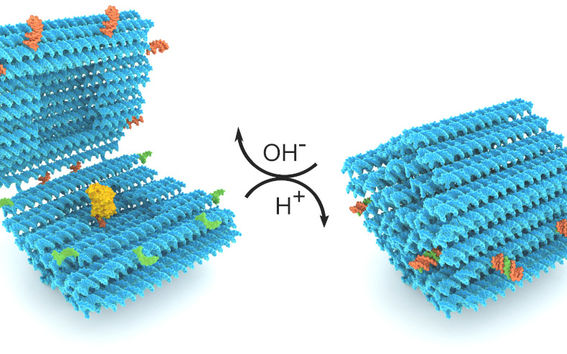DNA folds into a smart drug carrier

Researchers from Aalto University and the University of Jyväskylä in Finland have developed a customized DNA nanostructure that can perform a predefined task in human body-like conditions. To do so, the team built a capsule-like carrier that opens and closes according to the pH level of the surrounding solution. The nanocapsule can be loaded—or packed—with a variety of cargo, closed for delivery and opened again through a subtle pH increase.
'For quite some time I have wanted to build a dynamic DNA machine that would move with the help of an external stimulus, for example a biological cue. We picked up the concept of pH-responsive DNA strands from previous studies, developed the idea further, and demonstrated their applicability in a completely different setting,' says Veikko Linko, Adjunct Professor at Aalto University.
To make this happen, the team designed a capsule-like DNA origami structure functionalized with pH-responsive DNA strands. Such dynamic DNA nanodesigns are often controlled by the simple hydrogen-bonding of two complementary DNA sequences. Here, one half of the capsule was equipped with specific double-stranded DNA domains that could further form a DNA triple helix — in other words a helical structure comprised of three, not just two DNA molecules — by attaching to a suitable single-stranded DNA in the other half.
'The triplex formation can happen only when the surrounding pH of the solution is right,' explains first author of the study, doctoral student Heini Ijäs. 'We call these pH-responsive strands “pH latches”, because when the strands interact, they function similarly to their macroscopic counterparts and lock the capsule in a closed state. We included multiple motifs into our capsule design to facilitate the capsule opening/closing based on cooperative behaviour of the latches. The opening of the capsule is actually very rapid and requires only a slight pH increase in the solution,' she adds.
To harness the nanocapsules for transporting molecular payloads or therapeutic substances, the team designed the capsule with a cavity that could host different materials. They demonstrated that both gold nanoparticles and enzymes could be loaded (high pH) and encapsulated within the capsules (low pH) and again displayed (high pH). By monitoring the enzyme activity, the researchers found that the cargo remained fully functional over the course of the process.
'The most intriguing thing about the DNA origami capsules is that the threshold pH at which the opening and closing take place is fully adjustable by selecting the base sequences of the pH latches. We designed the threshold pH to be 7.2-7.3, close to the blood pH,' says Linko.
Further, the capsules remained functional at physiological magnesium and sodium concentrations, and in 10% blood plasma, and may continue to do at even higher plasma concentrations. Together, these findings help pave the way for developing smart and fully programmable drug-delivery vehicles for nanomedicine.
The work was carried out in Professor Mauri Kostiainen’s laboratory and led by Veikko Linko, both based at Aalto University.
The results were published in ACS Nano on 16 April 2019.
Picture:
Left: The pH-responsive DNA origami nanocapsule (blue) loaded with an enzyme (yellow color, high pH). The pH-latches have two counterparts: a double-stranded domain (orange) and a single-stranded sequence (green). Right: The DNA machine closes when pH is lowered, encapsulating the cargo with the help of triplex-forming latches. The capsule can be reopened and the cargo displayed with an increase in pH.
Links:
Article: H. Ijäs, et al. “Reconfigurable DNA Origami Nanocapsule for pH-Controlled Encapsulation and Display of Cargo.” https://dx.doi.org/10.1021/acsnano.9b01857
ACS Nano2019, DOI: 10.1021/acsnano.9b01857
More information:
Veikko Linko
Adjunct Professor
Biohybrid Materials Group, Aalto University School of Chemical Engineering, Finland
tel. +358 45 673 9997
[email protected]
Heini Ijäs
Doctoral Student
Department of Biological and Environmental Science, Nanoscience Center, University of Jyväskylä, Finland
Biohybrid Materials Group, Aalto University School of Chemical Engineering, Finland
[email protected] / [email protected]
The research has been funded by Academy of Finland, Jane and Aatos Erkko Foundation and the Sigrid Jusélius Foundation.
Read more news

DeployAI Partners Gather for Heart Beat Meeting in Helsinki
The European DeployAI project's partners gathered for the Heart Beat meeting hosted by Aalto University Executive Education in Helsinki.
Get to know us: Associate Professor Maria Sammalkorpi
Sammalkorpi received her doctorate from Helsinki University of Technology 2004. After her defence, she has worked as a researcher at the Universities of Princeton, Yale and Aalto.
Aalto computer scientists in ICML 2024
Computer scientists in ICML 2024